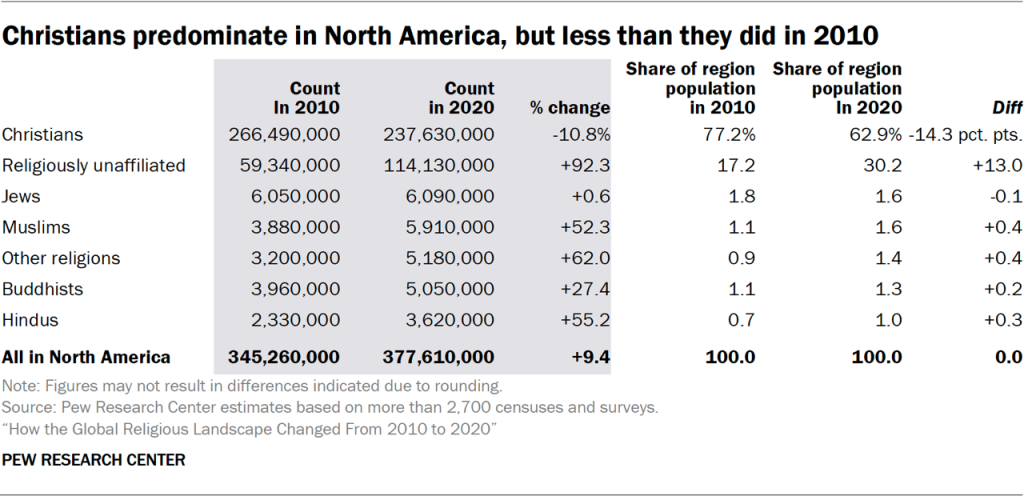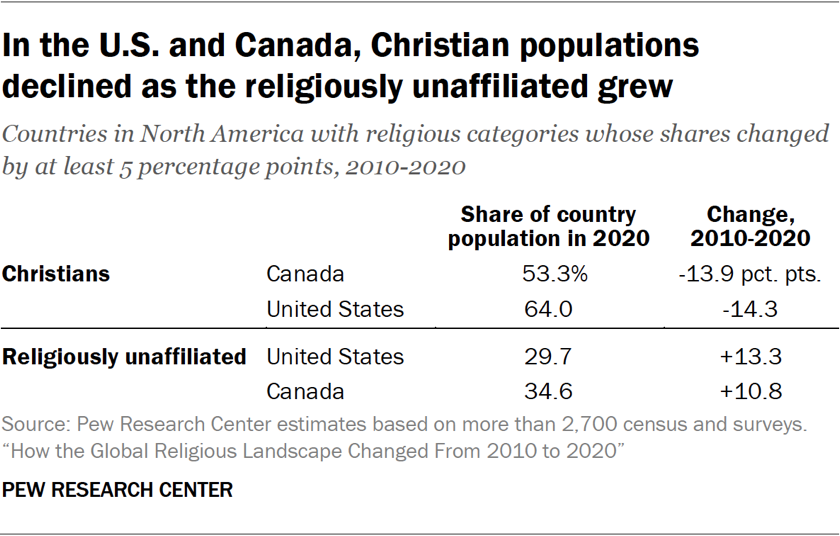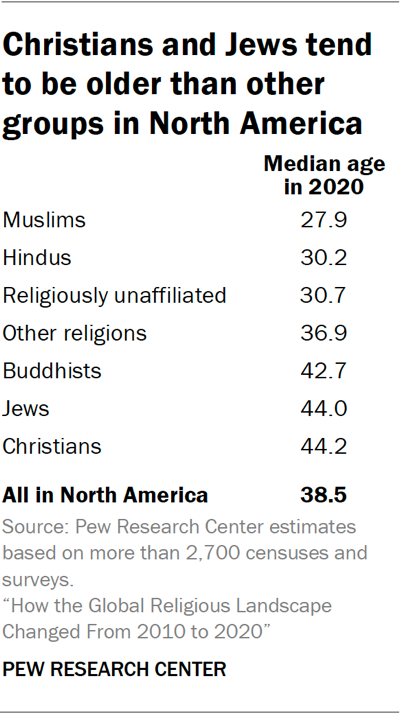North America – comprised in this report of the United States and Canada – had 378 million inhabitants in 2020, a 9% increase since 2010.29 Christians are by far the largest religious group in the region (63%), followed by religiously unaffiliated people (30%). All other groups, including Jews, Muslims, Buddhists and Hindus, each account for less than 2% of the population.
In the period from 201o to 2020, North America experienced large shifts in the shares of two religious categories: a steep drop in Christians as a percentage of the region’s overall population, and a corresponding rise in the percentage of the population that is religiously unaffiliated.
The prevailing pattern of change in the region is religious disaffiliation, particularly by people who say they were raised Christian but who have stopped identifying with any religion in adulthood.

Religious change
Christians were the only group in the region that declined in absolute number (or count) from 2010 to 2020, falling below 240 million (down 11%). Meanwhile, the number of religiously unaffiliated people almost doubled to 114 million (up 92%).
Several religious groups with smaller footprints in the region grew much faster than the region’s population overall. North American Muslims now number about 6 million (up 52%). People in the “other religions” category (up 62%) and Buddhists (up 27%) each have grown to more than 5 million. There also are about 4 million Hindus in the region, up 55% from 2010.
Most of the growth of Muslim and Hindu populations in the U.S. and Canada can be attributed to immigration.
North America’s Jewish population grew by only a few tens of thousands over the decade (up less than 1%), due to a relatively old age structure, low fertility rates and the absence of any major, new wave of Jewish immigration since the collapse of the Soviet Union. (For consistency with other religious groups, the definition of Jewishness in North America is based on self-identification with Judaism as a religion. It does not include people who describe their current religion as atheist, agnostic or “nothing in particular” but who consider themselves Jewish for reasons aside from religion, such as ancestry, culture or family background.30 Refer to Chapter 8 for more details.)
In terms of the percentage (or share) that each group made up, North America saw the two largest changes of any region: Christians dropped by 14 percentage points to 63% of the region’s population in 2020, while religiously unaffiliated people rose by 13 points to 30% of the population.
Every other group’s share of the population changed by less than 1 percentage point between 2010 and 2020.
Substantial change within countries
Between 2010 and 2020, both the U.S. and Canada experienced drops of about 14 percentage points in the share of their populations that are Christian. Christians now make up an estimated 64% of all U.S. residents and 53% of Canada’s inhabitants. Both countries’ religiously unaffiliated populations grew substantially over the same period (by at least 5 percentage points).

As of 2020, about 30% of U.S. residents (of all ages) do not identify with any religion, an increase of 13 points since 2010. In Canada, religiously unaffiliated people made up about 35% of the population in 2020, up 11 points since 2010.
Median age of religious groups
The median age of religious groups in North America ranges from 28 among Muslims to 44 among Christians. North America’s overall median age is 39 – the second-highest of any region of the world (after Europe, where the median age is 42).

In addition to Christians, Buddhists (43) and Jews (44) have higher median ages than the region overall. By comparison, Hindus (30) and the religiously unaffiliated (31) have relatively young populations in the region.




